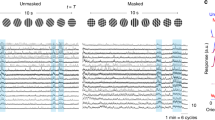Abstract
SENSORY systems can adapt to the conditions imposed on them1. In the visual system, adapting to a pattern increases the threshold of the ability to see that pattern, and reduces the perceived contrast of the pattern above threshold2–4. Most neurons of the striate cortex reduce their responsiveness after being stimulated for some time by a high-contrast pattern5–7. Such an effect may lie behind these psychophysical adaptation phenomena2–4. These adaptation effects have been reported to be confined to patterns of similar orientation, which is understandable in that the visual neurons that adapt are only excited by a small range of orientations8. Neurophysiological evidence suggests that neurons with different orientation preferences have inhibitory interconnections9–13. It is therefore of interest to explore the possible effects of these connections on perception. Here we show that adapting to a horizontal pattern can reduce the perceived contrast of a vertical test pattern more than a horizontal test pattern. These 'cross-orientation' effects are modelled by a division-like process, whereas the more normal 'similar-orientation' effects are modelled by a subtractive process.
This is a preview of subscription content, access via your institution
Access options
Subscribe to this journal
Receive 51 print issues and online access
$199.00 per year
only $3.90 per issue
Buy this article
- Purchase on Springer Link
- Instant access to full article PDF
Prices may be subject to local taxes which are calculated during checkout
Similar content being viewed by others
References
Mollon, J. D. New Scient 61, 479–482 (1974).
Gilinsky, A. S. J. opt. Soc. Am. 58, 13–17 (1968).
Blakemore, C. & Nachmias, J. J. Physiol., Lond. 213, 157–174 (1971).
Blakemore, C., Muncey, J. P. J. & Ridley, R. M. Vision Res. 13, 1915–1931 (1973).
Maffei, L. Fiorentini, A. & Bisti, S. Science 182, 1036–1038 (1973).
Movshon, J. A. & Lennie, P. Nature 278, 850–852 (1979).
Ohzawa, I., Sclar, G. & Freeman, R. D. Nature 298, 266–268 (1982).
Hubel, D. & Weisel, T. J. Physiol. Lond. 195, 215–243 (1968).
Beneveto, L. A., Creutzfelt, O. D. & Kuhnt, U. Nature 238, 124–126 (1972).
Sillito, A. M. Trends Neurosci. 2, 196–198 (1979).
Morrone, M. C., Burr, D. C. & Maffei, L. Proc. R. Soc. B216, 335–354 (1982).
Ramoa, A. S., Shadlen, M., Skottun, B. C. & Freeman, R. D. Nature 321, 237–239 (1986).
Bonds, A. B. Vis. Neurosci. 2, 41–55 (1989).
Georgeson, M. A. Spat. Vision 1, 103–112 (1985).
Dealy, R. S. & Tolhurst, D. J. J. Physiol., Lond. 241, 261–270 (1974).
Albrecht, D. G. & Hamilton, D. B. J. Neurophys. 48, 217–237 (1982).
Tolhurst, D. J., Movshon, J. A. & Thompson, I. D. Expl Brain Res. 41, 414–419 (1981).
Gibson, J. J. & Radner, M. J. exp. Psychol. 20, 453–467 (1937).
Heeley, D. W. Vision Res. 29, 1229–1236 (1979).
Blakemore, C. B. & Sutton, P. Science 166, 245–247 (1971).
Greenlee, M. W. & Magnussen, S. Vision Res. 28, 1303–1310 (1988).
Morrone, M. C. & Burr, D. C. Nature 321, 235–237 (1986).
Snowden, R. J., Treue, S., Erickson, R. E. & Andersen, R. A. J. Neurosci. 11, 2768–2785 (1991).
Dean, A. F., Hess, R. F. & Tolhurst, D. J. J. Physiol., Lond. 308, 84 (1980).
Author information
Authors and Affiliations
Rights and permissions
About this article
Cite this article
Snowden, R., Hammett, S. Subtractive and divisive adaptation in the human visual system. Nature 355, 248–250 (1992). https://doi.org/10.1038/355248a0
Received:
Accepted:
Issue Date:
DOI: https://doi.org/10.1038/355248a0
Comments
By submitting a comment you agree to abide by our Terms and Community Guidelines. If you find something abusive or that does not comply with our terms or guidelines please flag it as inappropriate.



